Cultural Considerations in Patient Care
VerifiedAdded on 2020/03/04
|11
|2887
|289
AI Summary
This assignment explores the influence of culture on patient care, particularly focusing on pain management. It delves into various cultural beliefs and practices surrounding health, illness, and treatment seeking. The analysis draws upon several research articles that highlight diverse patient experiences across different cultures, including Chinese American, Aboriginal Australian, and Maori populations.
Contribute Materials
Your contribution can guide someone’s learning journey. Share your
documents today.
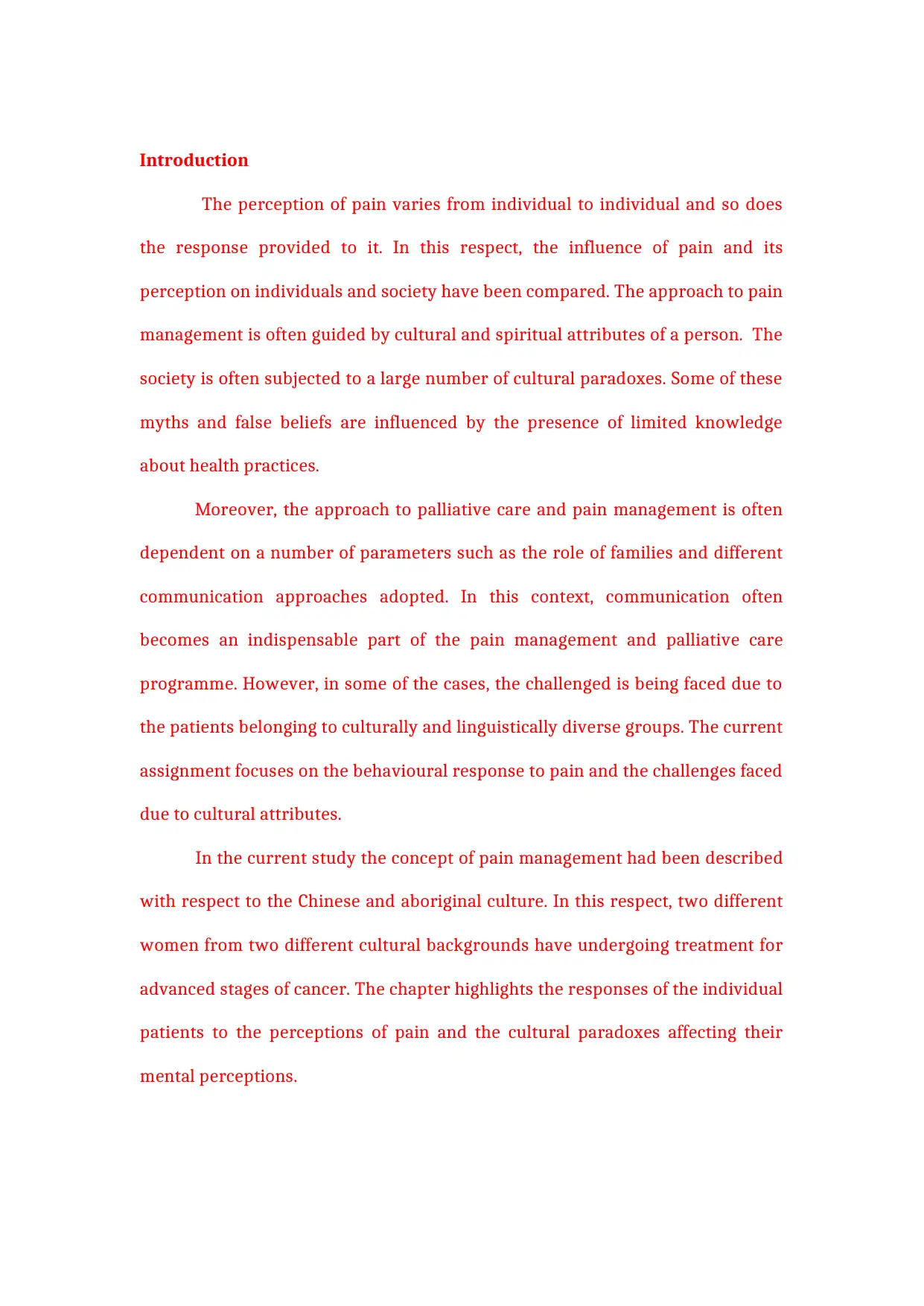
Introduction
The perception of pain varies from individual to individual and so does
the response provided to it. In this respect, the influence of pain and its
perception on individuals and society have been compared. The approach to pain
management is often guided by cultural and spiritual attributes of a person. The
society is often subjected to a large number of cultural paradoxes. Some of these
myths and false beliefs are influenced by the presence of limited knowledge
about health practices.
Moreover, the approach to palliative care and pain management is often
dependent on a number of parameters such as the role of families and different
communication approaches adopted. In this context, communication often
becomes an indispensable part of the pain management and palliative care
programme. However, in some of the cases, the challenged is being faced due to
the patients belonging to culturally and linguistically diverse groups. The current
assignment focuses on the behavioural response to pain and the challenges faced
due to cultural attributes.
In the current study the concept of pain management had been described
with respect to the Chinese and aboriginal culture. In this respect, two different
women from two different cultural backgrounds have undergoing treatment for
advanced stages of cancer. The chapter highlights the responses of the individual
patients to the perceptions of pain and the cultural paradoxes affecting their
mental perceptions.
The perception of pain varies from individual to individual and so does
the response provided to it. In this respect, the influence of pain and its
perception on individuals and society have been compared. The approach to pain
management is often guided by cultural and spiritual attributes of a person. The
society is often subjected to a large number of cultural paradoxes. Some of these
myths and false beliefs are influenced by the presence of limited knowledge
about health practices.
Moreover, the approach to palliative care and pain management is often
dependent on a number of parameters such as the role of families and different
communication approaches adopted. In this context, communication often
becomes an indispensable part of the pain management and palliative care
programme. However, in some of the cases, the challenged is being faced due to
the patients belonging to culturally and linguistically diverse groups. The current
assignment focuses on the behavioural response to pain and the challenges faced
due to cultural attributes.
In the current study the concept of pain management had been described
with respect to the Chinese and aboriginal culture. In this respect, two different
women from two different cultural backgrounds have undergoing treatment for
advanced stages of cancer. The chapter highlights the responses of the individual
patients to the perceptions of pain and the cultural paradoxes affecting their
mental perceptions.
Secure Best Marks with AI Grader
Need help grading? Try our AI Grader for instant feedback on your assignments.

Body:
Pain is a dynamic, unpleasant sensory experience with any physical, social, and
psychological implications. Pain transcends all cultural boundaries, with no
preference as to who will be afflicted. While pain is a universal human
experience, thebehavioural response to pain is controlled by a wide variety of
factors such as the health, cultural belief, psychological makeup and different
social factors (Tung & Li, 2015). Each social and cultural group has its own
unique language of distress and pain, its own complex expression by which
unpleasant patients make other people aware of their pain.
In the context of Mrs Jessie being affected by old world norms believed that her
present condition could be relieved alone by the traditional medication. She had
little or no belief in the modern day biomedical approach to pain management
and care.Mrs, Jessie belonging from an aboriginal cultural group might be
exposed to a number of cultural paradoxes. Some of these paradoxes might
develop into cultural frictions, which affects the quality of the care services. For
aboriginal people the chatting about pain may lead the conversation into the
political areas of the land land rights and stolen generation. According to
Fenwick & Stevens, (2006) aboriginal people suppress pain behaviours and
demonstrate reluctance to discuss their pain experience with others. It means
aboriginal patients are reluctant to report pain to health care provider: main
reasons were the lack of established trust relationships with health care
professionals and a need to be brave. The pain are fatiguing, sometimes
aboriginal people exhibit a unique and subtle pain behaviour and language, a
slight upward nod of the head with downcast eyes when asked if in pain;
Pain is a dynamic, unpleasant sensory experience with any physical, social, and
psychological implications. Pain transcends all cultural boundaries, with no
preference as to who will be afflicted. While pain is a universal human
experience, thebehavioural response to pain is controlled by a wide variety of
factors such as the health, cultural belief, psychological makeup and different
social factors (Tung & Li, 2015). Each social and cultural group has its own
unique language of distress and pain, its own complex expression by which
unpleasant patients make other people aware of their pain.
In the context of Mrs Jessie being affected by old world norms believed that her
present condition could be relieved alone by the traditional medication. She had
little or no belief in the modern day biomedical approach to pain management
and care.Mrs, Jessie belonging from an aboriginal cultural group might be
exposed to a number of cultural paradoxes. Some of these paradoxes might
develop into cultural frictions, which affects the quality of the care services. For
aboriginal people the chatting about pain may lead the conversation into the
political areas of the land land rights and stolen generation. According to
Fenwick & Stevens, (2006) aboriginal people suppress pain behaviours and
demonstrate reluctance to discuss their pain experience with others. It means
aboriginal patients are reluctant to report pain to health care provider: main
reasons were the lack of established trust relationships with health care
professionals and a need to be brave. The pain are fatiguing, sometimes
aboriginal people exhibit a unique and subtle pain behaviour and language, a
slight upward nod of the head with downcast eyes when asked if in pain;
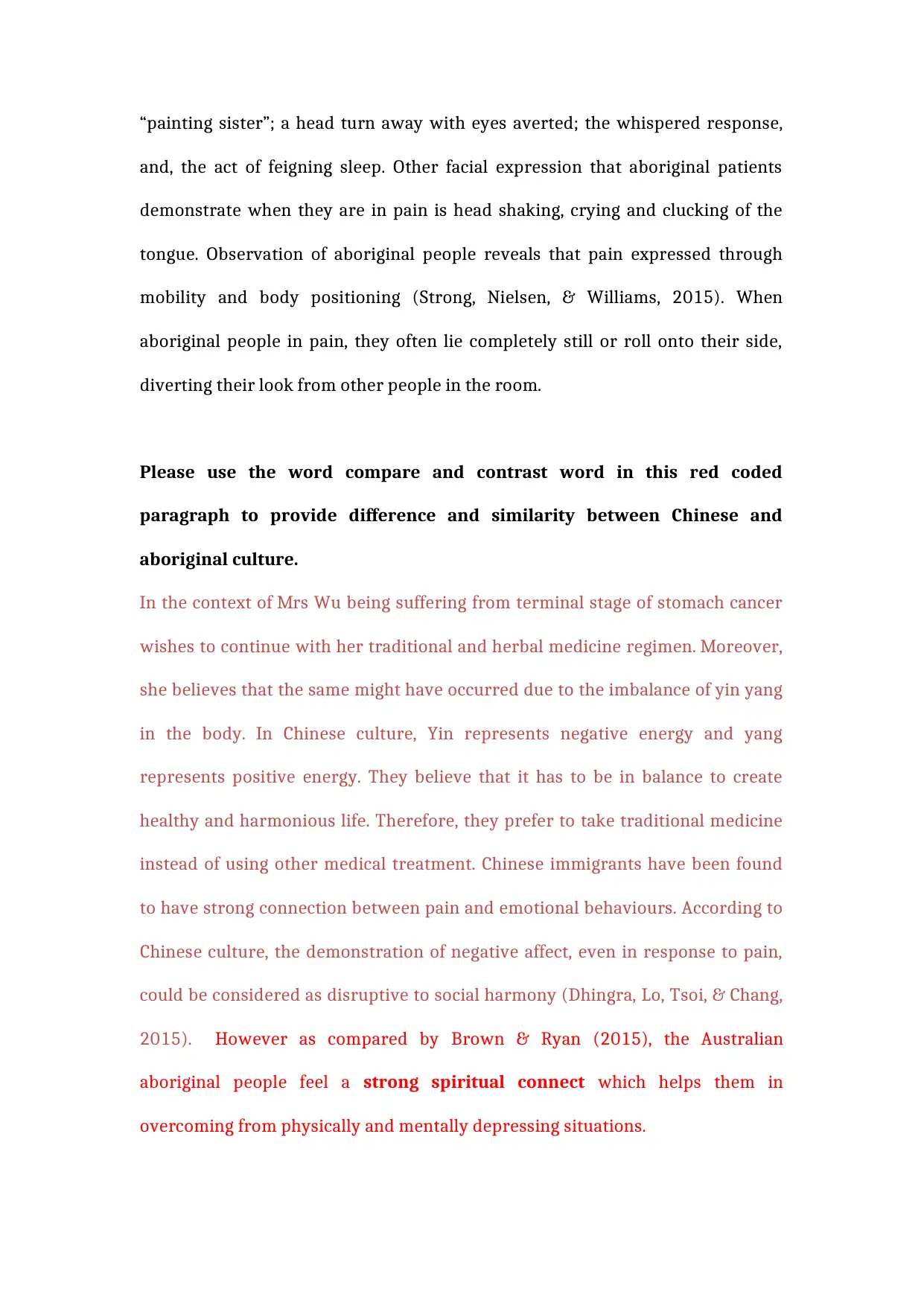
“painting sister”; a head turn away with eyes averted; the whispered response,
and, the act of feigning sleep. Other facial expression that aboriginal patients
demonstrate when they are in pain is head shaking, crying and clucking of the
tongue. Observation of aboriginal people reveals that pain expressed through
mobility and body positioning (Strong, Nielsen, & Williams, 2015). When
aboriginal people in pain, they often lie completely still or roll onto their side,
diverting their look from other people in the room.
Please use the word compare and contrast word in this red coded
paragraph to provide difference and similarity between Chinese and
aboriginal culture.
In the context of Mrs Wu being suffering from terminal stage of stomach cancer
wishes to continue with her traditional and herbal medicine regimen. Moreover,
she believes that the same might have occurred due to the imbalance of yin yang
in the body. In Chinese culture, Yin represents negative energy and yang
represents positive energy. They believe that it has to be in balance to create
healthy and harmonious life. Therefore, they prefer to take traditional medicine
instead of using other medical treatment. Chinese immigrants have been found
to have strong connection between pain and emotional behaviours. According to
Chinese culture, the demonstration of negative affect, even in response to pain,
could be considered as disruptive to social harmony (Dhingra, Lo, Tsoi, & Chang,
2015). However as compared by Brown & Ryan (2015), the Australian
aboriginal people feel a strong spiritual connect which helps them in
overcoming from physically and mentally depressing situations.
and, the act of feigning sleep. Other facial expression that aboriginal patients
demonstrate when they are in pain is head shaking, crying and clucking of the
tongue. Observation of aboriginal people reveals that pain expressed through
mobility and body positioning (Strong, Nielsen, & Williams, 2015). When
aboriginal people in pain, they often lie completely still or roll onto their side,
diverting their look from other people in the room.
Please use the word compare and contrast word in this red coded
paragraph to provide difference and similarity between Chinese and
aboriginal culture.
In the context of Mrs Wu being suffering from terminal stage of stomach cancer
wishes to continue with her traditional and herbal medicine regimen. Moreover,
she believes that the same might have occurred due to the imbalance of yin yang
in the body. In Chinese culture, Yin represents negative energy and yang
represents positive energy. They believe that it has to be in balance to create
healthy and harmonious life. Therefore, they prefer to take traditional medicine
instead of using other medical treatment. Chinese immigrants have been found
to have strong connection between pain and emotional behaviours. According to
Chinese culture, the demonstration of negative affect, even in response to pain,
could be considered as disruptive to social harmony (Dhingra, Lo, Tsoi, & Chang,
2015). However as compared by Brown & Ryan (2015), the Australian
aboriginal people feel a strong spiritual connect which helps them in
overcoming from physically and mentally depressing situations.
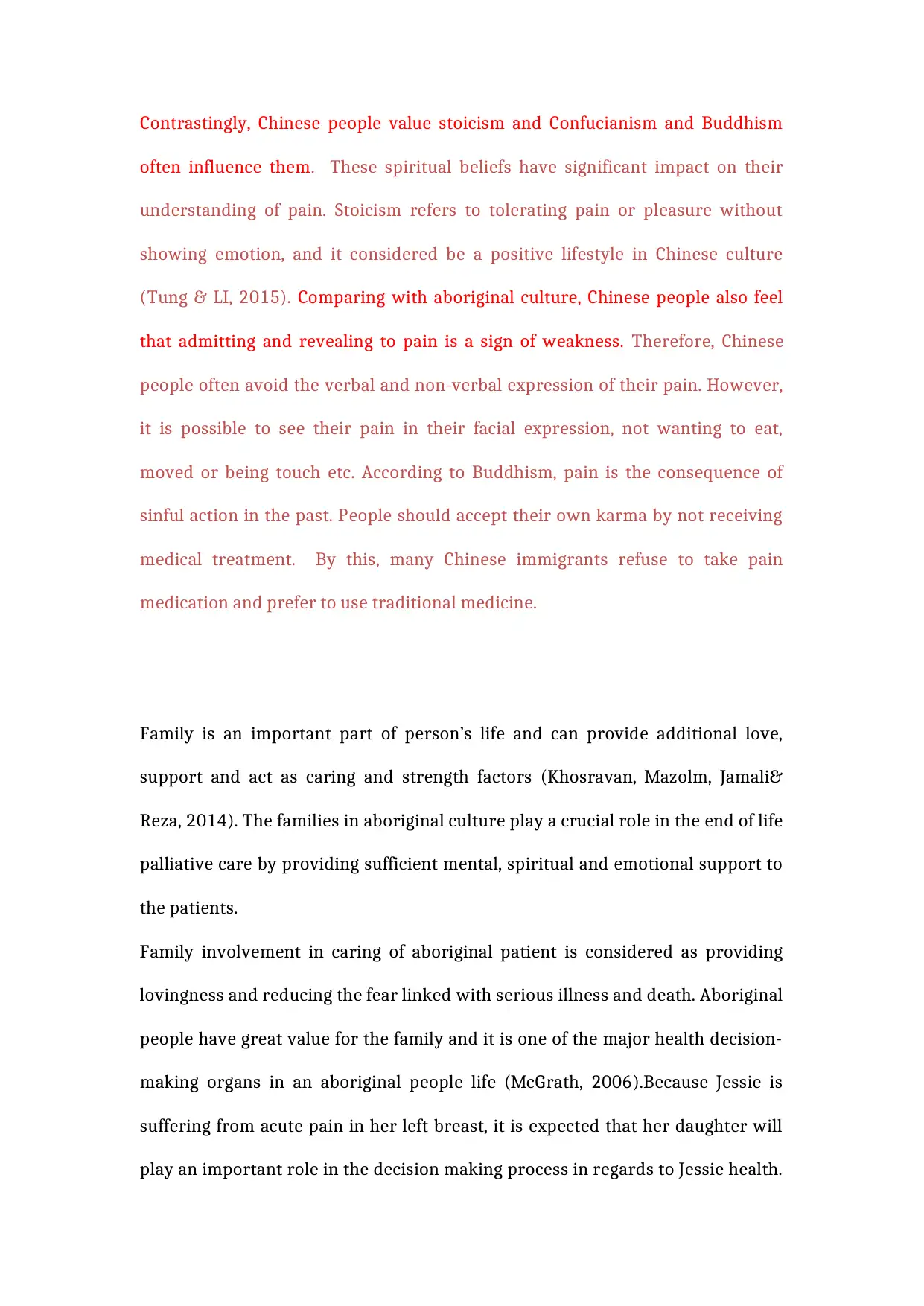
Contrastingly, Chinese people value stoicism and Confucianism and Buddhism
often influence them. These spiritual beliefs have significant impact on their
understanding of pain. Stoicism refers to tolerating pain or pleasure without
showing emotion, and it considered be a positive lifestyle in Chinese culture
(Tung & LI, 2015). Comparing with aboriginal culture, Chinese people also feel
that admitting and revealing to pain is a sign of weakness. Therefore, Chinese
people often avoid the verbal and non-verbal expression of their pain. However,
it is possible to see their pain in their facial expression, not wanting to eat,
moved or being touch etc. According to Buddhism, pain is the consequence of
sinful action in the past. People should accept their own karma by not receiving
medical treatment. By this, many Chinese immigrants refuse to take pain
medication and prefer to use traditional medicine.
Family is an important part of person’s life and can provide additional love,
support and act as caring and strength factors (Khosravan, Mazolm, Jamali&
Reza, 2014). The families in aboriginal culture play a crucial role in the end of life
palliative care by providing sufficient mental, spiritual and emotional support to
the patients.
Family involvement in caring of aboriginal patient is considered as providing
lovingness and reducing the fear linked with serious illness and death. Aboriginal
people have great value for the family and it is one of the major health decision-
making organs in an aboriginal people life (McGrath, 2006).Because Jessie is
suffering from acute pain in her left breast, it is expected that her daughter will
play an important role in the decision making process in regards to Jessie health.
often influence them. These spiritual beliefs have significant impact on their
understanding of pain. Stoicism refers to tolerating pain or pleasure without
showing emotion, and it considered be a positive lifestyle in Chinese culture
(Tung & LI, 2015). Comparing with aboriginal culture, Chinese people also feel
that admitting and revealing to pain is a sign of weakness. Therefore, Chinese
people often avoid the verbal and non-verbal expression of their pain. However,
it is possible to see their pain in their facial expression, not wanting to eat,
moved or being touch etc. According to Buddhism, pain is the consequence of
sinful action in the past. People should accept their own karma by not receiving
medical treatment. By this, many Chinese immigrants refuse to take pain
medication and prefer to use traditional medicine.
Family is an important part of person’s life and can provide additional love,
support and act as caring and strength factors (Khosravan, Mazolm, Jamali&
Reza, 2014). The families in aboriginal culture play a crucial role in the end of life
palliative care by providing sufficient mental, spiritual and emotional support to
the patients.
Family involvement in caring of aboriginal patient is considered as providing
lovingness and reducing the fear linked with serious illness and death. Aboriginal
people have great value for the family and it is one of the major health decision-
making organs in an aboriginal people life (McGrath, 2006).Because Jessie is
suffering from acute pain in her left breast, it is expected that her daughter will
play an important role in the decision making process in regards to Jessie health.
Secure Best Marks with AI Grader
Need help grading? Try our AI Grader for instant feedback on your assignments.
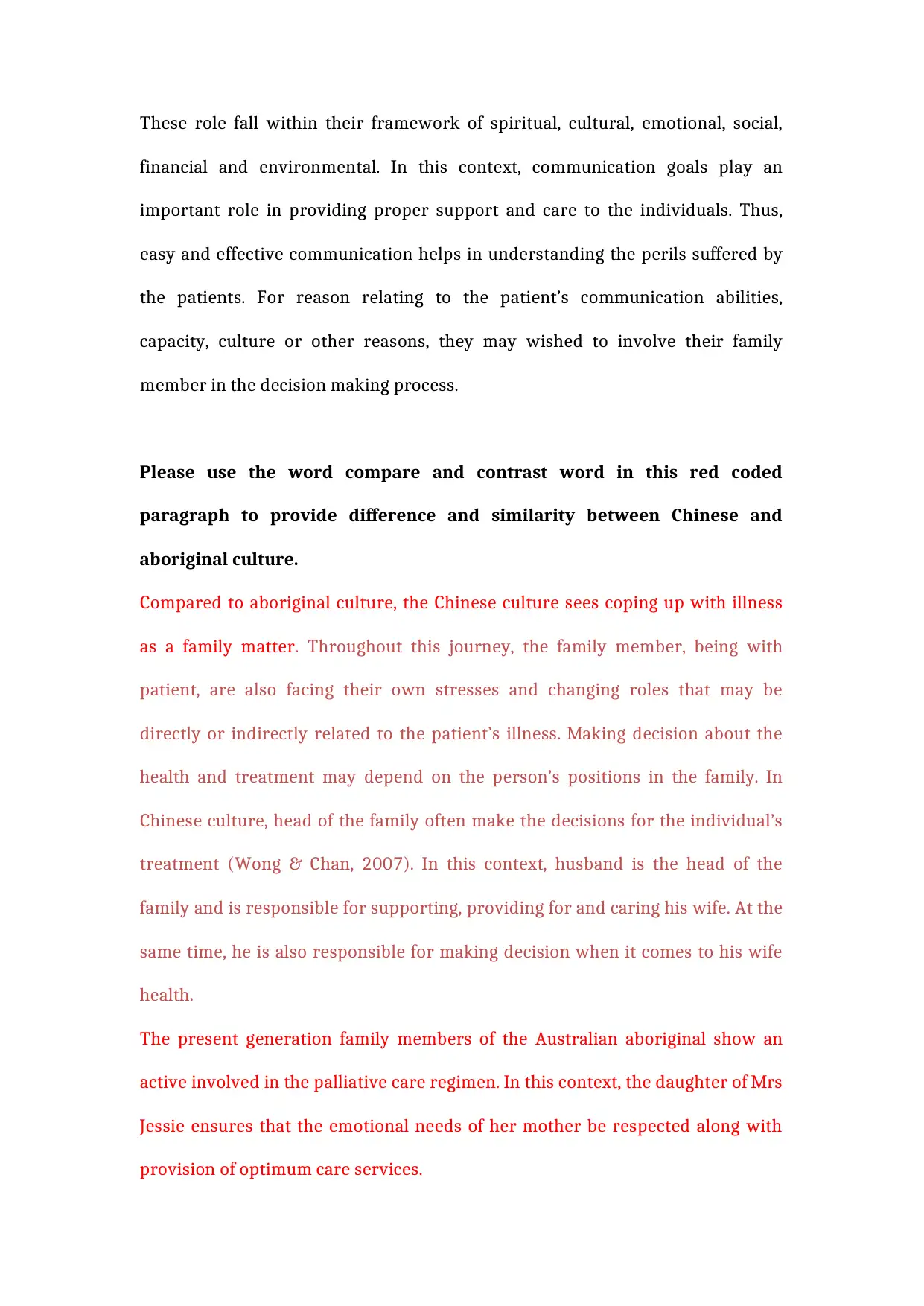
These role fall within their framework of spiritual, cultural, emotional, social,
financial and environmental. In this context, communication goals play an
important role in providing proper support and care to the individuals. Thus,
easy and effective communication helps in understanding the perils suffered by
the patients. For reason relating to the patient’s communication abilities,
capacity, culture or other reasons, they may wished to involve their family
member in the decision making process.
Please use the word compare and contrast word in this red coded
paragraph to provide difference and similarity between Chinese and
aboriginal culture.
Compared to aboriginal culture, the Chinese culture sees coping up with illness
as a family matter. Throughout this journey, the family member, being with
patient, are also facing their own stresses and changing roles that may be
directly or indirectly related to the patient’s illness. Making decision about the
health and treatment may depend on the person’s positions in the family. In
Chinese culture, head of the family often make the decisions for the individual’s
treatment (Wong & Chan, 2007). In this context, husband is the head of the
family and is responsible for supporting, providing for and caring his wife. At the
same time, he is also responsible for making decision when it comes to his wife
health.
The present generation family members of the Australian aboriginal show an
active involved in the palliative care regimen. In this context, the daughter of Mrs
Jessie ensures that the emotional needs of her mother be respected along with
provision of optimum care services.
financial and environmental. In this context, communication goals play an
important role in providing proper support and care to the individuals. Thus,
easy and effective communication helps in understanding the perils suffered by
the patients. For reason relating to the patient’s communication abilities,
capacity, culture or other reasons, they may wished to involve their family
member in the decision making process.
Please use the word compare and contrast word in this red coded
paragraph to provide difference and similarity between Chinese and
aboriginal culture.
Compared to aboriginal culture, the Chinese culture sees coping up with illness
as a family matter. Throughout this journey, the family member, being with
patient, are also facing their own stresses and changing roles that may be
directly or indirectly related to the patient’s illness. Making decision about the
health and treatment may depend on the person’s positions in the family. In
Chinese culture, head of the family often make the decisions for the individual’s
treatment (Wong & Chan, 2007). In this context, husband is the head of the
family and is responsible for supporting, providing for and caring his wife. At the
same time, he is also responsible for making decision when it comes to his wife
health.
The present generation family members of the Australian aboriginal show an
active involved in the palliative care regimen. In this context, the daughter of Mrs
Jessie ensures that the emotional needs of her mother be respected along with
provision of optimum care services.
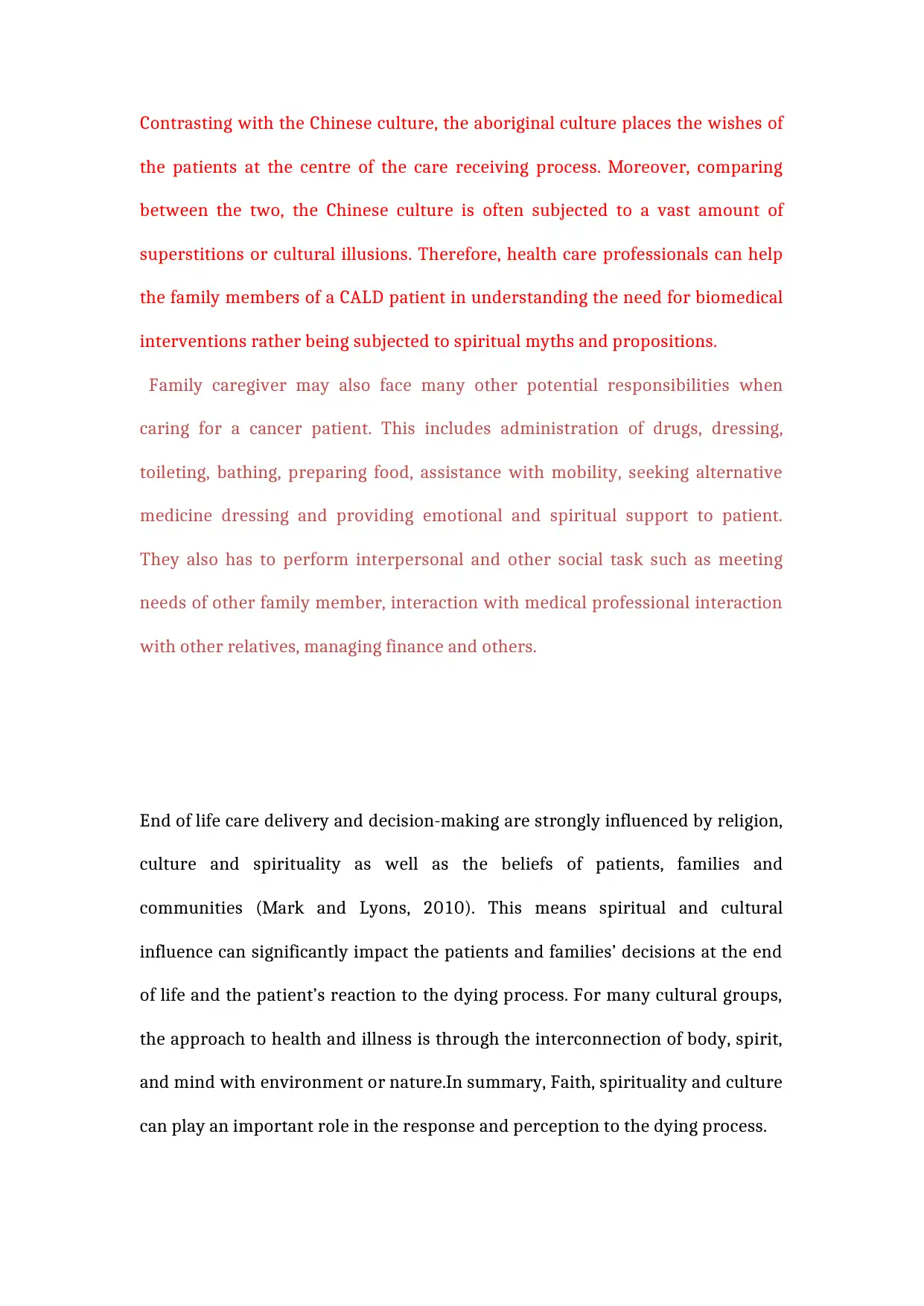
Contrasting with the Chinese culture, the aboriginal culture places the wishes of
the patients at the centre of the care receiving process. Moreover, comparing
between the two, the Chinese culture is often subjected to a vast amount of
superstitions or cultural illusions. Therefore, health care professionals can help
the family members of a CALD patient in understanding the need for biomedical
interventions rather being subjected to spiritual myths and propositions.
Family caregiver may also face many other potential responsibilities when
caring for a cancer patient. This includes administration of drugs, dressing,
toileting, bathing, preparing food, assistance with mobility, seeking alternative
medicine dressing and providing emotional and spiritual support to patient.
They also has to perform interpersonal and other social task such as meeting
needs of other family member, interaction with medical professional interaction
with other relatives, managing finance and others.
End of life care delivery and decision-making are strongly influenced by religion,
culture and spirituality as well as the beliefs of patients, families and
communities (Mark and Lyons, 2010). This means spiritual and cultural
influence can significantly impact the patients and families’ decisions at the end
of life and the patient’s reaction to the dying process. For many cultural groups,
the approach to health and illness is through the interconnection of body, spirit,
and mind with environment or nature.In summary, Faith, spirituality and culture
can play an important role in the response and perception to the dying process.
the patients at the centre of the care receiving process. Moreover, comparing
between the two, the Chinese culture is often subjected to a vast amount of
superstitions or cultural illusions. Therefore, health care professionals can help
the family members of a CALD patient in understanding the need for biomedical
interventions rather being subjected to spiritual myths and propositions.
Family caregiver may also face many other potential responsibilities when
caring for a cancer patient. This includes administration of drugs, dressing,
toileting, bathing, preparing food, assistance with mobility, seeking alternative
medicine dressing and providing emotional and spiritual support to patient.
They also has to perform interpersonal and other social task such as meeting
needs of other family member, interaction with medical professional interaction
with other relatives, managing finance and others.
End of life care delivery and decision-making are strongly influenced by religion,
culture and spirituality as well as the beliefs of patients, families and
communities (Mark and Lyons, 2010). This means spiritual and cultural
influence can significantly impact the patients and families’ decisions at the end
of life and the patient’s reaction to the dying process. For many cultural groups,
the approach to health and illness is through the interconnection of body, spirit,
and mind with environment or nature.In summary, Faith, spirituality and culture
can play an important role in the response and perception to the dying process.
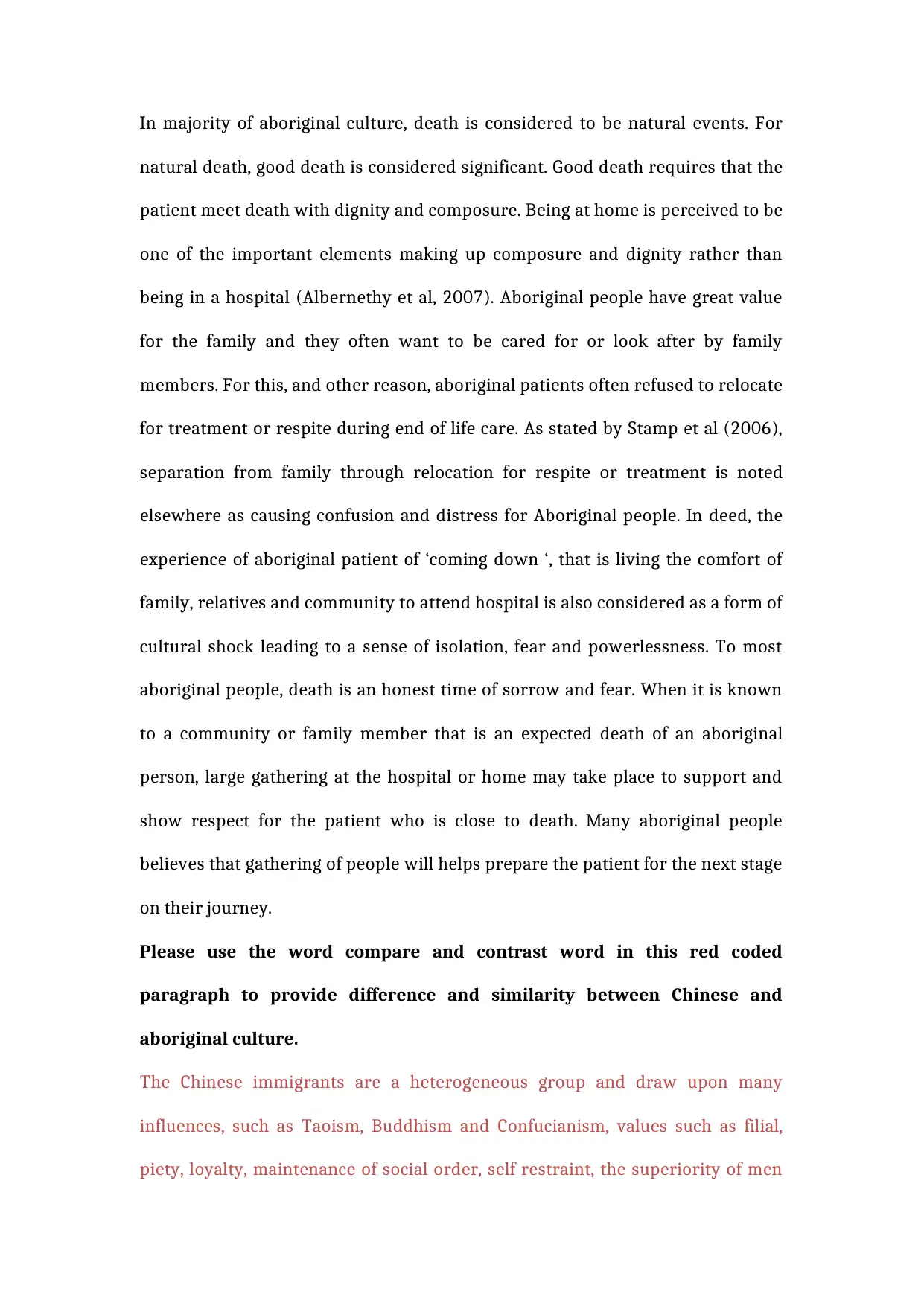
In majority of aboriginal culture, death is considered to be natural events. For
natural death, good death is considered significant. Good death requires that the
patient meet death with dignity and composure. Being at home is perceived to be
one of the important elements making up composure and dignity rather than
being in a hospital (Albernethy et al, 2007). Aboriginal people have great value
for the family and they often want to be cared for or look after by family
members. For this, and other reason, aboriginal patients often refused to relocate
for treatment or respite during end of life care. As stated by Stamp et al (2006),
separation from family through relocation for respite or treatment is noted
elsewhere as causing confusion and distress for Aboriginal people. In deed, the
experience of aboriginal patient of ‘coming down ‘, that is living the comfort of
family, relatives and community to attend hospital is also considered as a form of
cultural shock leading to a sense of isolation, fear and powerlessness. To most
aboriginal people, death is an honest time of sorrow and fear. When it is known
to a community or family member that is an expected death of an aboriginal
person, large gathering at the hospital or home may take place to support and
show respect for the patient who is close to death. Many aboriginal people
believes that gathering of people will helps prepare the patient for the next stage
on their journey.
Please use the word compare and contrast word in this red coded
paragraph to provide difference and similarity between Chinese and
aboriginal culture.
The Chinese immigrants are a heterogeneous group and draw upon many
influences, such as Taoism, Buddhism and Confucianism, values such as filial,
piety, loyalty, maintenance of social order, self restraint, the superiority of men
natural death, good death is considered significant. Good death requires that the
patient meet death with dignity and composure. Being at home is perceived to be
one of the important elements making up composure and dignity rather than
being in a hospital (Albernethy et al, 2007). Aboriginal people have great value
for the family and they often want to be cared for or look after by family
members. For this, and other reason, aboriginal patients often refused to relocate
for treatment or respite during end of life care. As stated by Stamp et al (2006),
separation from family through relocation for respite or treatment is noted
elsewhere as causing confusion and distress for Aboriginal people. In deed, the
experience of aboriginal patient of ‘coming down ‘, that is living the comfort of
family, relatives and community to attend hospital is also considered as a form of
cultural shock leading to a sense of isolation, fear and powerlessness. To most
aboriginal people, death is an honest time of sorrow and fear. When it is known
to a community or family member that is an expected death of an aboriginal
person, large gathering at the hospital or home may take place to support and
show respect for the patient who is close to death. Many aboriginal people
believes that gathering of people will helps prepare the patient for the next stage
on their journey.
Please use the word compare and contrast word in this red coded
paragraph to provide difference and similarity between Chinese and
aboriginal culture.
The Chinese immigrants are a heterogeneous group and draw upon many
influences, such as Taoism, Buddhism and Confucianism, values such as filial,
piety, loyalty, maintenance of social order, self restraint, the superiority of men
Paraphrase This Document
Need a fresh take? Get an instant paraphrase of this document with our AI Paraphraser
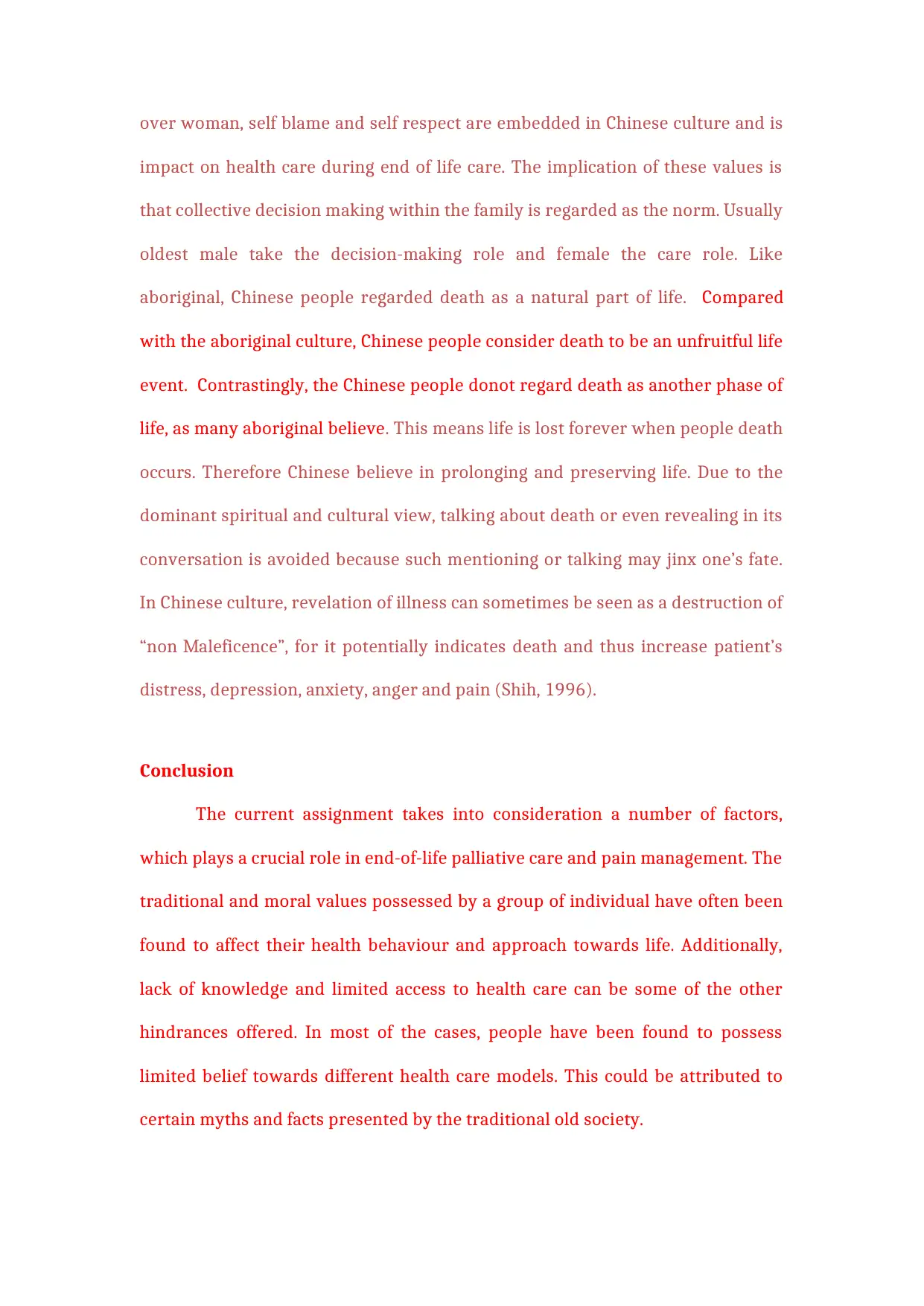
over woman, self blame and self respect are embedded in Chinese culture and is
impact on health care during end of life care. The implication of these values is
that collective decision making within the family is regarded as the norm. Usually
oldest male take the decision-making role and female the care role. Like
aboriginal, Chinese people regarded death as a natural part of life. Compared
with the aboriginal culture, Chinese people consider death to be an unfruitful life
event. Contrastingly, the Chinese people donot regard death as another phase of
life, as many aboriginal believe. This means life is lost forever when people death
occurs. Therefore Chinese believe in prolonging and preserving life. Due to the
dominant spiritual and cultural view, talking about death or even revealing in its
conversation is avoided because such mentioning or talking may jinx one’s fate.
In Chinese culture, revelation of illness can sometimes be seen as a destruction of
“non Maleficence”, for it potentially indicates death and thus increase patient’s
distress, depression, anxiety, anger and pain (Shih, 1996).
Conclusion
The current assignment takes into consideration a number of factors,
which plays a crucial role in end-of-life palliative care and pain management. The
traditional and moral values possessed by a group of individual have often been
found to affect their health behaviour and approach towards life. Additionally,
lack of knowledge and limited access to health care can be some of the other
hindrances offered. In most of the cases, people have been found to possess
limited belief towards different health care models. This could be attributed to
certain myths and facts presented by the traditional old society.
impact on health care during end of life care. The implication of these values is
that collective decision making within the family is regarded as the norm. Usually
oldest male take the decision-making role and female the care role. Like
aboriginal, Chinese people regarded death as a natural part of life. Compared
with the aboriginal culture, Chinese people consider death to be an unfruitful life
event. Contrastingly, the Chinese people donot regard death as another phase of
life, as many aboriginal believe. This means life is lost forever when people death
occurs. Therefore Chinese believe in prolonging and preserving life. Due to the
dominant spiritual and cultural view, talking about death or even revealing in its
conversation is avoided because such mentioning or talking may jinx one’s fate.
In Chinese culture, revelation of illness can sometimes be seen as a destruction of
“non Maleficence”, for it potentially indicates death and thus increase patient’s
distress, depression, anxiety, anger and pain (Shih, 1996).
Conclusion
The current assignment takes into consideration a number of factors,
which plays a crucial role in end-of-life palliative care and pain management. The
traditional and moral values possessed by a group of individual have often been
found to affect their health behaviour and approach towards life. Additionally,
lack of knowledge and limited access to health care can be some of the other
hindrances offered. In most of the cases, people have been found to possess
limited belief towards different health care models. This could be attributed to
certain myths and facts presented by the traditional old society.
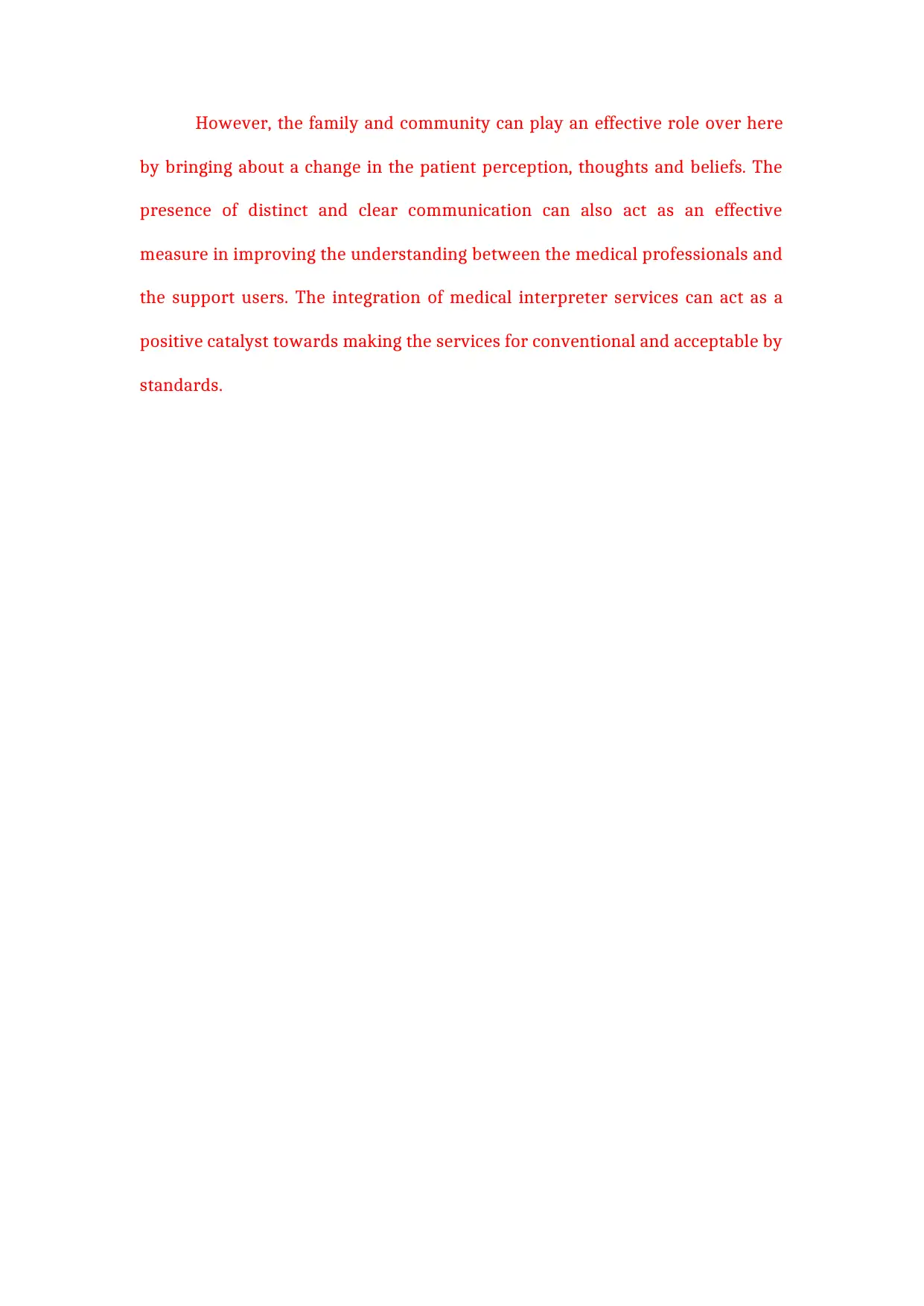
However, the family and community can play an effective role over here
by bringing about a change in the patient perception, thoughts and beliefs. The
presence of distinct and clear communication can also act as an effective
measure in improving the understanding between the medical professionals and
the support users. The integration of medical interpreter services can act as a
positive catalyst towards making the services for conventional and acceptable by
standards.
by bringing about a change in the patient perception, thoughts and beliefs. The
presence of distinct and clear communication can also act as an effective
measure in improving the understanding between the medical professionals and
the support users. The integration of medical interpreter services can act as a
positive catalyst towards making the services for conventional and acceptable by
standards.
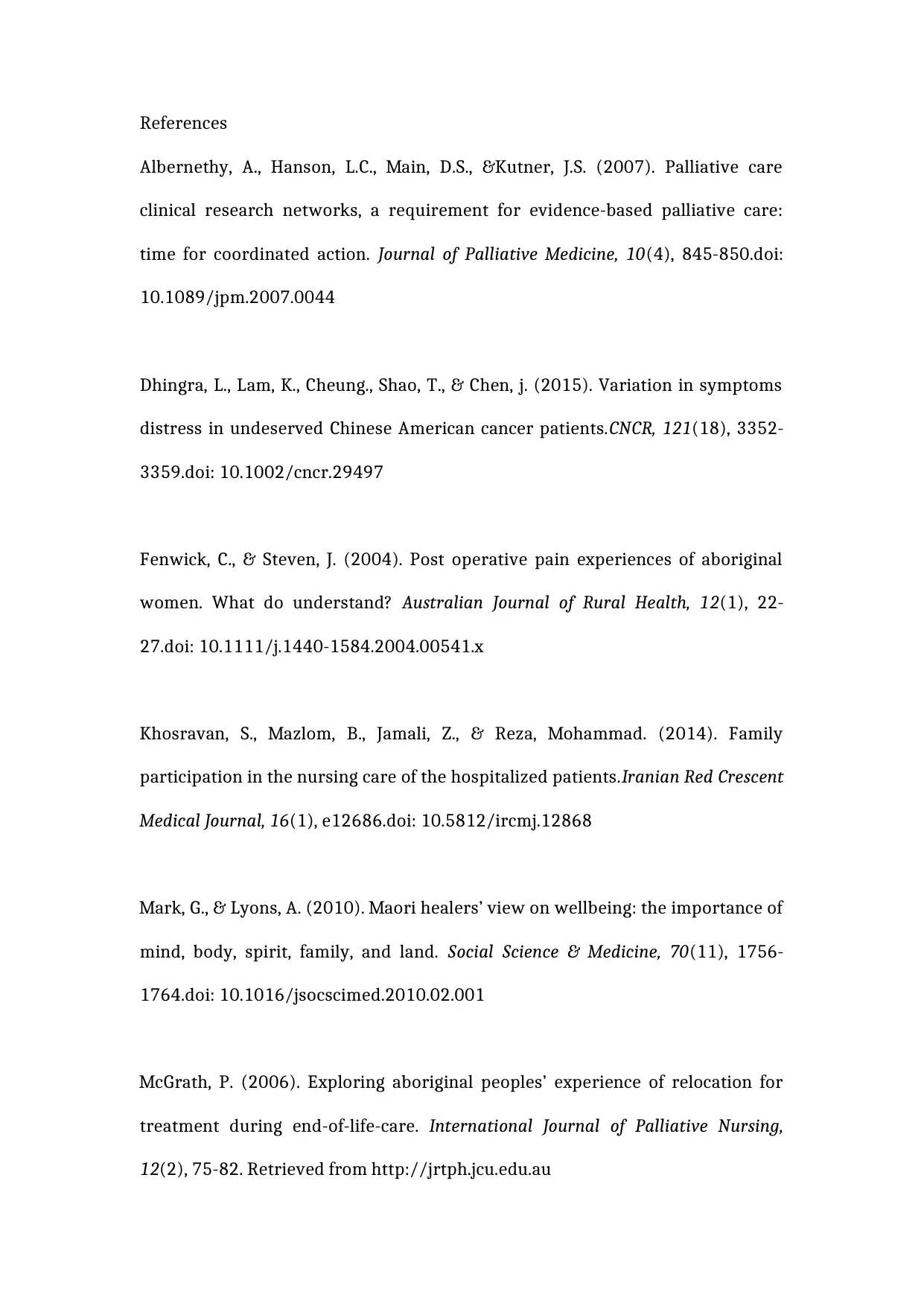
References
Albernethy, A., Hanson, L.C., Main, D.S., &Kutner, J.S. (2007). Palliative care
clinical research networks, a requirement for evidence-based palliative care:
time for coordinated action. Journal of Palliative Medicine, 10(4), 845-850.doi:
10.1089/jpm.2007.0044
Dhingra, L., Lam, K., Cheung., Shao, T., & Chen, j. (2015). Variation in symptoms
distress in undeserved Chinese American cancer patients.CNCR, 121(18), 3352-
3359.doi: 10.1002/cncr.29497
Fenwick, C., & Steven, J. (2004). Post operative pain experiences of aboriginal
women. What do understand? Australian Journal of Rural Health, 12(1), 22-
27.doi: 10.1111/j.1440-1584.2004.00541.x
Khosravan, S., Mazlom, B., Jamali, Z., & Reza, Mohammad. (2014). Family
participation in the nursing care of the hospitalized patients.Iranian Red Crescent
Medical Journal, 16(1), e12686.doi: 10.5812/ircmj.12868
Mark, G., & Lyons, A. (2010). Maori healers’ view on wellbeing: the importance of
mind, body, spirit, family, and land. Social Science & Medicine, 70(11), 1756-
1764.doi: 10.1016/jsocscimed.2010.02.001
McGrath, P. (2006). Exploring aboriginal peoples’ experience of relocation for
treatment during end-of-life-care. International Journal of Palliative Nursing,
12(2), 75-82. Retrieved from http://jrtph.jcu.edu.au
Albernethy, A., Hanson, L.C., Main, D.S., &Kutner, J.S. (2007). Palliative care
clinical research networks, a requirement for evidence-based palliative care:
time for coordinated action. Journal of Palliative Medicine, 10(4), 845-850.doi:
10.1089/jpm.2007.0044
Dhingra, L., Lam, K., Cheung., Shao, T., & Chen, j. (2015). Variation in symptoms
distress in undeserved Chinese American cancer patients.CNCR, 121(18), 3352-
3359.doi: 10.1002/cncr.29497
Fenwick, C., & Steven, J. (2004). Post operative pain experiences of aboriginal
women. What do understand? Australian Journal of Rural Health, 12(1), 22-
27.doi: 10.1111/j.1440-1584.2004.00541.x
Khosravan, S., Mazlom, B., Jamali, Z., & Reza, Mohammad. (2014). Family
participation in the nursing care of the hospitalized patients.Iranian Red Crescent
Medical Journal, 16(1), e12686.doi: 10.5812/ircmj.12868
Mark, G., & Lyons, A. (2010). Maori healers’ view on wellbeing: the importance of
mind, body, spirit, family, and land. Social Science & Medicine, 70(11), 1756-
1764.doi: 10.1016/jsocscimed.2010.02.001
McGrath, P. (2006). Exploring aboriginal peoples’ experience of relocation for
treatment during end-of-life-care. International Journal of Palliative Nursing,
12(2), 75-82. Retrieved from http://jrtph.jcu.edu.au
Secure Best Marks with AI Grader
Need help grading? Try our AI Grader for instant feedback on your assignments.
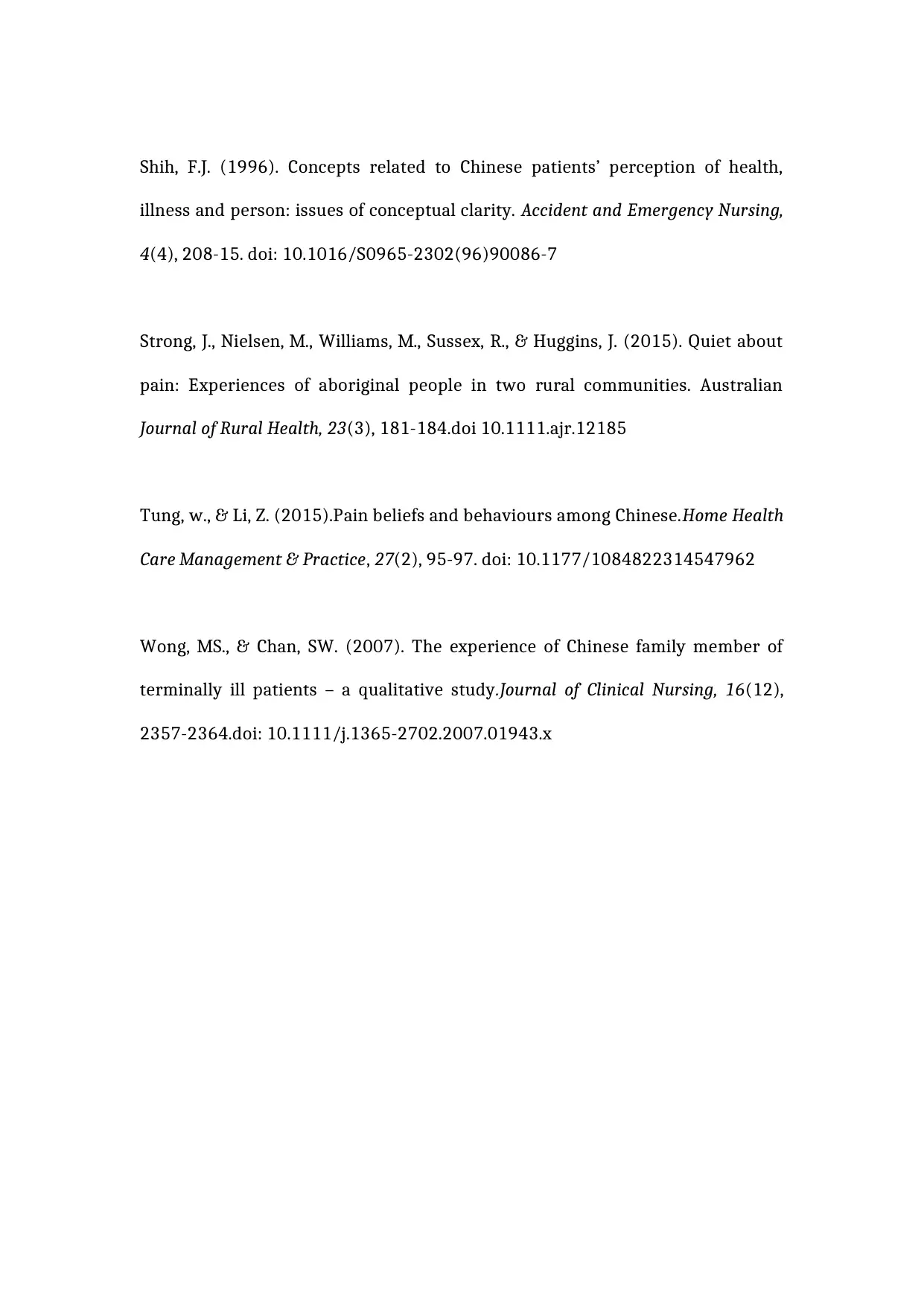
Shih, F.J. (1996). Concepts related to Chinese patients’ perception of health,
illness and person: issues of conceptual clarity. Accident and Emergency Nursing,
4(4), 208-15. doi: 10.1016/S0965-2302(96)90086-7
Strong, J., Nielsen, M., Williams, M., Sussex, R., & Huggins, J. (2015). Quiet about
pain: Experiences of aboriginal people in two rural communities. Australian
Journal of Rural Health, 23(3), 181-184.doi 10.1111.ajr.12185
Tung, w., & Li, Z. (2015).Pain beliefs and behaviours among Chinese.Home Health
Care Management & Practice, 27(2), 95-97. doi: 10.1177/1084822314547962
Wong, MS., & Chan, SW. (2007). The experience of Chinese family member of
terminally ill patients – a qualitative study.Journal of Clinical Nursing, 16(12),
2357-2364.doi: 10.1111/j.1365-2702.2007.01943.x
illness and person: issues of conceptual clarity. Accident and Emergency Nursing,
4(4), 208-15. doi: 10.1016/S0965-2302(96)90086-7
Strong, J., Nielsen, M., Williams, M., Sussex, R., & Huggins, J. (2015). Quiet about
pain: Experiences of aboriginal people in two rural communities. Australian
Journal of Rural Health, 23(3), 181-184.doi 10.1111.ajr.12185
Tung, w., & Li, Z. (2015).Pain beliefs and behaviours among Chinese.Home Health
Care Management & Practice, 27(2), 95-97. doi: 10.1177/1084822314547962
Wong, MS., & Chan, SW. (2007). The experience of Chinese family member of
terminally ill patients – a qualitative study.Journal of Clinical Nursing, 16(12),
2357-2364.doi: 10.1111/j.1365-2702.2007.01943.x
1 out of 11
Related Documents
Your All-in-One AI-Powered Toolkit for Academic Success.
+13062052269
info@desklib.com
Available 24*7 on WhatsApp / Email
![[object Object]](/_next/static/media/star-bottom.7253800d.svg)
Unlock your academic potential
© 2024 | Zucol Services PVT LTD | All rights reserved.





